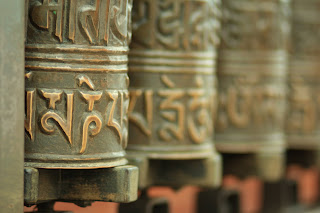




On the 16th of July, our group went to a 7AM Buddhist meditation service in a lovely, small village located on a beautiful hilltop overlooking the expanse of the Kathmandu Valley and breathtaking views of the misty Himalayas. We were invited into the service by one of the Buddhist masters, who welcomed us with honorary stoles and introduced us to the villagers in the service. The people of the village were warm, friendly, kind people who loved to make sure we were doing everything correctly during the service. Several members of our group commented later on how much energy it took to sit completely still, on straw mats over a rocky terrain, while your bum and legs were falling asleep. I believe we all have the tune of "Om mani padme hum" forever engrained in our brains. After the service, everyone got up to go to the front and present an offering to the gods. Many of the ladies in the service shoved rupees (Nepali currency) into our hands in order for us to have an offering to give. I thought that was so kind of them to think of us, showing up with nothing, having nothing but our curiosity to give, and they made sure we had something to offer. The funny thing was, every time we turned around to get out of the tent, someone else would shove money in our hands and we would have to do it all over again. Then, we found that Nepalis love having their photo taken and looking at it on digital cameras, so many of our group have pictures of the lovely villagers who were so kind and welcoming to us. There were about 130 people at the service, which was almost double what it usually is, according to the masters. They told us that they let the villagers know ahead of time that a group from an American university was coming, so they all came out with a strong showing. They were just as curious about us as we were of them. I have so many pictures of beautiful faces and warm hearts--I may not know their names, but somehow they are not strangers.
After the service, we were invited to the office of the Buddhist masters who keep this wonderful program going. They served us masala tea and fresh fried doughnuts (YUM!), and told us all about their mission to keep the 500 year old village vibrant and keep their faith going strong. Then the masters, or "brothers", as the group of friends called themselves, took us on a visit around the village, showing us their wonderful temples and shrines. These "brothers" are an awesome group of men; all had professional jobs in addition to their masters of Buddhism, and took the time every day to hold services for the villagers to keep the faith alive. Some are doctors, some engineers, all are passionate about preserving their faith and their village. The hardest part of the visit was hearing about how many precious icons have been stolen from the village (which is a widely-based problem across Nepal). It was sad to see how the villagers must appreciate their statues and shrines through bars and steel rods that prevent the items from being stolen.
The brothers are amazing people doing great things. I sincerely hope that through writing about the village and sharing our photos, we can find a way to help the brothers raise their village up and continue the tradition and beauty of their ancient faith.








